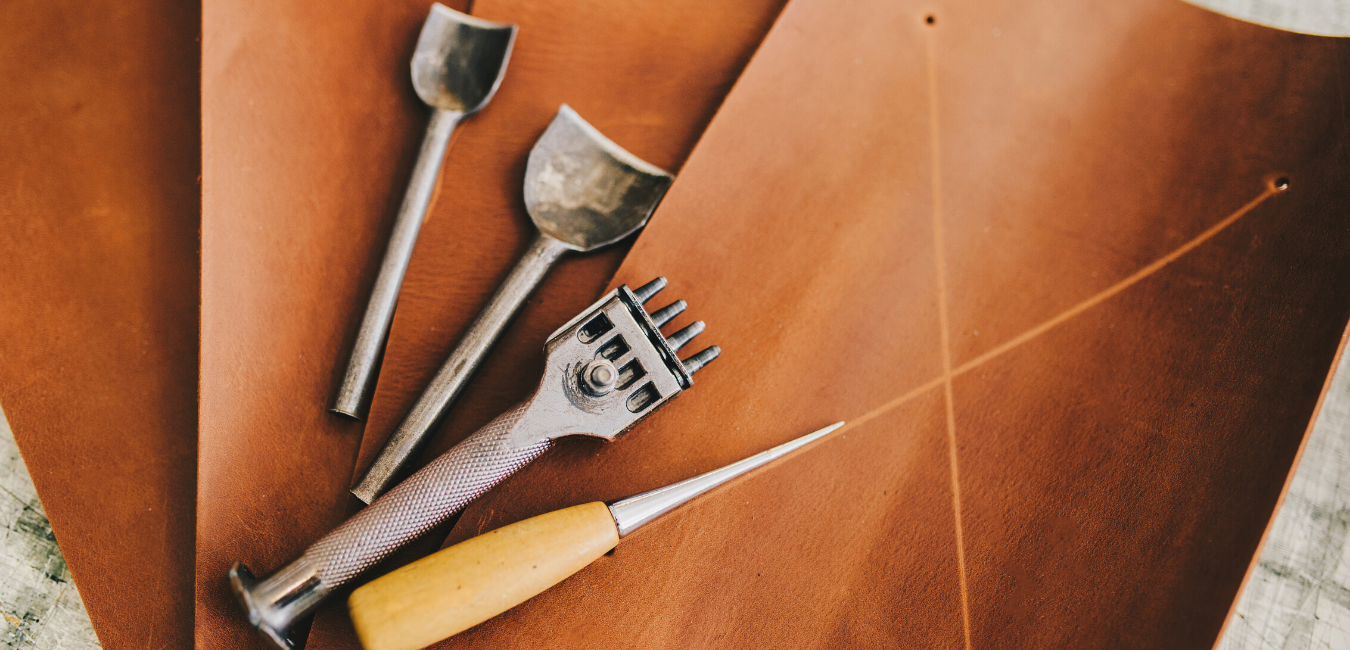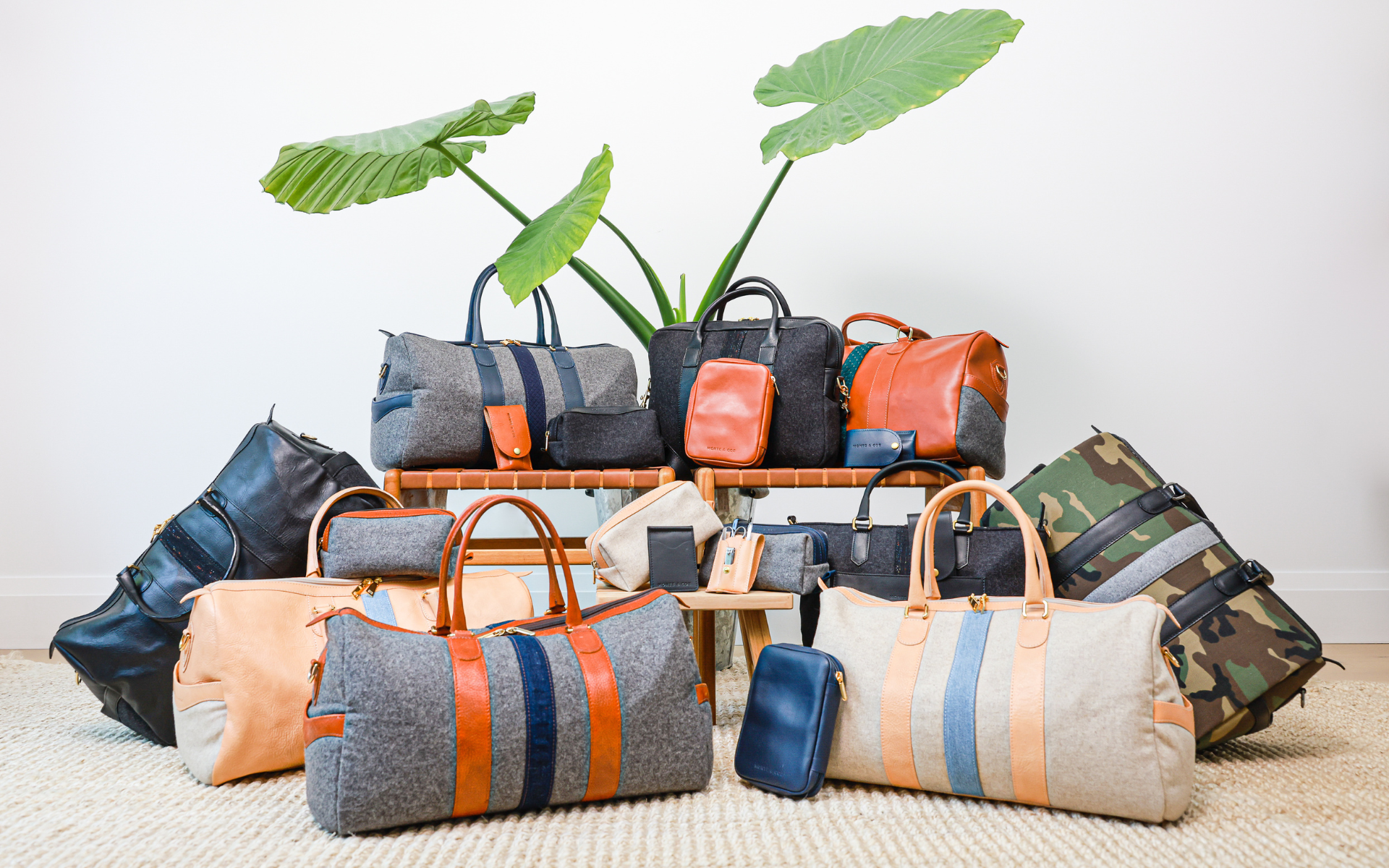
Leather 101: A Beginners Guide to Leather
Some of the most common questions we get from our customers are often related to the type of leather we use in the making of our weekender bags and travel accessories.
Because of all the terms used by brands in the market, shopping for leather products can extremely confusing.

Wool Weekender in Grey & Navy - $700 USD Leather Weekender in Cognac - $788 USD
We often hear questions like what is vegetable tanned leather? What is chrome- tanned leather? What is genuine leather, or faux leather or, vegan leather?
Admittedly, this all sounds very confusing and cumbersome.
Many of these terms come from the way leather is made and that's exactly why we created this guide to help you understand what it all means.
 The leather production process can be categorized into three broad categories: Preparatory Stage, Tanning Stage, and Post-Tanning Stage.
The leather production process can be categorized into three broad categories: Preparatory Stage, Tanning Stage, and Post-Tanning Stage.
Each stage adds various characteristics that help describe the various types of leather that exist in the market.
THE PREP STAGE: WHAT IS LEATHER MADE OF?
Leather is a raw material made from animal hides and the most popular type is cowhide.
In this initial stage, there are ample pre-treatment components the hides are treated with, the most common being preservation, de-hairing, de-fleshing, and splitting.
Splitting is when leather is cut into two or more horizontal layers. Each of these layers represents a different grade or quality of leather.
via Leatherpavlat
Generally speaking, the closer the leather is to the epidermis or the hair, the higher the quality.
This is because collagen bundles in the hide are much tighter near the top, which gives full-grain leather that firm texture.
Full-grain leather is typically recognized as the highest quality of leather in terms of durability and toughness.
 via Wanderlust Galleria
via Wanderlust Galleria
WHAT IS NUBUCK LEATHER?
Nubuck leather is top-grain leather that has been buffed to have short and soft protein fibers that give it a velvety feel.
WHAT IS GENUINE LEATHER?
Genuine leather and suede are the contents of a hide that are split from the grain leather and lay closer to the flesh. Intuitively this makes sense since suede is most commonly referred to as the backside of the leather. Less dense collagen bundles are what give suede its soft texture. Suede is often referred to as Nappa leather, which is a distinction made due to the nappy texture of suede itself.
THE TANNING STAGE: HOW IS LEATHER MADE?
The tanning process is much like the process of taking raw grapes and fermenting them to become wine. The process is designed to change the molecular compound of collagen, the protein found in the skin. Without tanning, a skin would putrefy and degrade due to the exposure to liquid in the hide itself. Essentially, tanning is designed to draw this liquid out of the skin.

via Frederico Gutierrez & Vince Gx
There are various tanning methods that can be used, however, the most common are Vegetable Tanned and Chrome Tanned.

WHAT IS CHROME TANNING?
Engineered 19th century, chrome tanning is the modern method of tanning using a heavy metal chromium sulfate. These treatments are typically completed by placing the hides in large spinning drums where a tanning liquid is absorbed by the hide. Using this method, the tanning process normally takes only one day, however, the trade-off is the negative impact this method has on the environment due to the metallic nature of the chromium chemical and acids used in the liquid.
WHAT IS VEGETABLE TANNING?
Vegetable Tanning is an ancient, more eco-friendly process that uses oils from vegetation, like bark, to treat the leather hides.
This method is a traditional craft dating back thousands of years. It is a lengthier and more costly way of tanning and thus less than 10% of the world’s leather is vegetable tanned. It takes nearly 70 days to properly tan a hide using the veg tan process.
It is far more labor-intensive taking up to three months to complete, hence the higher price tag on any goods made using Vegetable Tanned Leather.
Vegetable-tanned leather is also friendlier to the environment and is also biodegradable.
THE POST-TANNING STAGE: HOW IS LEATHER FINISHED?
Once the tanning process is complete, leather hides are ready to be coloured and finished.
Tanned hides are tumbled in large drums to ensure dyes are evenly distributed.
via Redwingheritage
The two types of dyes most commonly used are Aniline and Semi-Aniline.
Aniline dye is a water-based solution with no added pigments or oils.
This method is friendlier to the environment and offers a true reveal of the hide's natural characteristics and markings.
Leather coloured with aniline dye offers a softer finish with a more natural leather feel and smell.
You will notice if you run your fingernail over this leather that a mark will instantly appear, which can be buffed out just as easily with your finger or a damp cloth.
Semi-Aniline dyes include oils and pigments which results in a more firm dense finish to the hide.

Once the leather hides are dyed, they can be conditioned with fats and oils to stuff and fill the gaps the hides may still have.
Certain leathers like bridle leather are stuffed with hot waxes and oils on both sides of the hide to yield its durability and stiffness.

via Shutterstock
The leathers are then hang dried and finished with a protective coating to give it a smooth texture.

At Monte & Coe, leather stands as a fundamental pillar, and our commitment to transparency sets us apart. We take immense pride in openly sharing the details of the materials we utilize, ensuring our customers are well-informed about our dedication to employing only the finest and most eco-concious options available in the market. Moreover, we believe in enlightening our valued customers about the intricate process behind the meticulous handcrafting of each Monte & Coe weekender bag. Tap to learn more about our vegetable tanned leather.







Leave a comment
This site is protected by hCaptcha and the hCaptcha Privacy Policy and Terms of Service apply.